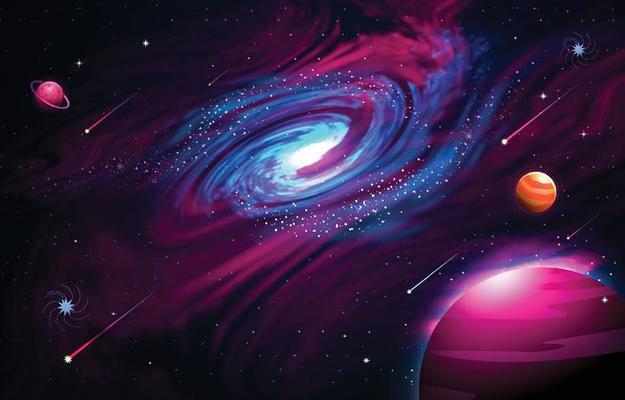Picture this: I was about ten years old, sneaking out to the backyard with my dad’s old binoculars. The night sky looked like a velvet blanket sprinkled with diamonds, but one hazy streak caught my eye—the Milky Way. Back then, I had no clue it was our home galaxy, a swirling island of stars in an endless sea. That moment sparked a lifelong fascination with these vast structures. If you’re new to astronomy, this guide will walk you through what galaxies are, why they matter, and how you can start exploring them yourself. We’ll keep it simple, fun, and packed with tips to get you stargazing without feeling overwhelmed.
What Exactly Is a Galaxy?
Imagine a galaxy as a gigantic family reunion in space—billions of stars, planets, gas, dust, and mysterious dark matter all hanging out, held together by gravity’s invisible grip. These cosmic neighborhoods come in various sizes, from dwarf ones with a few billion stars to giants boasting trillions. Our understanding has evolved, especially with recent telescopes revealing galaxies formed just after the Big Bang.
The Building Blocks: Stars, Gas, and More
Stars are the shining heart of any galaxy, born from collapsing clouds of gas and dust. Add in planets orbiting those stars, plus exotic stuff like black holes, and you’ve got a dynamic system. Dark matter, that unseen force making up most of a galaxy’s mass, keeps everything from flying apart—think of it as the silent guardian.
How Galaxies Differ from the Universe
A galaxy is just one piece of the puzzle; the universe is the whole picture, containing billions of galaxies stretched across unimaginable distances. It’s like comparing a city to the entire planet—galaxies are local hubs in a vast cosmic web.
The Main Types of Galaxies
Galaxies aren’t cookie-cutter; they boast shapes that hint at their wild histories. From elegant spirals to chunky ellipticals, each type tells a story of crashes, births, and quiet retirements. Recent discoveries, like those from the James Webb Space Telescope, show even ancient galaxies had surprising structures.
Spiral Galaxies: Twirling Beauties
Spirals feature a flat disk with arms winding out like a cosmic pinwheel, full of young stars and gas clouds. They’re active nurseries for new worlds. Our Milky Way fits this bill, making it feel personal when I spot its arms on a clear night.
Elliptical Galaxies: Smooth Operators
Ellipticals resemble giant eggs—smooth, featureless, and packed with older stars. They form from mergers, where galaxies smash together and lose their gas. Less flashy, but their stability is like a wise old sage in the sky.
Irregular Galaxies: The Rebels
Irregulars look messy, lacking defined shapes due to gravitational tugs or collisions. They’re bursting with star formation, like a party that got out of hand. Think of them as the free spirits of the galaxy world.
Lenticular Galaxies: The Hybrids
Lenticulars have a disk like spirals but no arms, bridging the gap between types. They’re gassy yet form few stars, offering a middle-ground vibe.
To break it down, here’s a handy table comparing galaxy types:
| Galaxy Type | Shape Description | Star Formation Level | Famous Example |
|---|---|---|---|
| Spiral | Disk with arms | High | Milky Way |
| Elliptical | Oval or spherical | Low | M87 |
| Irregular | Chaotic, blob-like | Variable | Large Magellanic Cloud |
| Lenticular | Lens-shaped disk | Moderate | Sombrero Galaxy |
- Pros of Observing Spirals: Vibrant details, easy to spot arms with basic gear.
- Cons: Dust can obscure views, requiring darker skies.
- Pros of Ellipticals: Bright and steady, great for faint-object hunting.
- Cons: Lack drama—no swirling arms to wow beginners.
When comparing spirals to irregulars, it’s like a ballet dancer versus a rock concert: one graceful, the other energetic and unpredictable.
Our Home: The Milky Way Galaxy
We’re not just floating in space; we’re part of the Milky Way, a barred spiral that’s been our address for billions of years. I remember my first time using a telescope to trace its dusty lanes—it felt like discovering a hidden map to treasure. This galaxy spans 100,000 light-years, hosting everything from our sun to supermassive black holes.
Fascinating Facts About the Milky Way
It’s about 13 billion years old, with a central black hole called Sagittarius A* that’s four million times the sun’s mass. Recent studies show it’s warping like a potato chip and has “eaten” smaller galaxies over time. Fun twist: We’re speeding through space at 1.3 million miles per hour.
Its Structure: From Core to Halo
A bright bulge at the center bulges with old stars, while spiral arms extend out, cradling gas for new ones. A halo of dark matter and ancient star clusters envelopes it all. Visualizing it edge-on is like slicing a pizza—you see the layers.
Neighbors and Future Drama
The Milky Way belongs to the Local Group, with Andromeda as our nearest big neighbor. In four billion years, they’ll merge, but stars won’t collide due to vast spaces. It’ll create a new elliptical—talk about a family reunion!
Quick bullet points on Milky Way must-knows:
- Home to 200-400 billion stars, including potential alien worlds.
- Best viewed in summer from the Southern Hemisphere for the core.
- Contains “fossil” remnants from ancient mergers, like stellar streams.
How Galaxies Form and Evolve
Galaxies start as tiny clumps in the early universe’s fog, growing through gravity and mergers. It’s a slow dance over billions of years, from chaotic beginnings to structured beauties. I once attended an astronomy talk where the speaker likened it to baking bread—ingredients mix, rise, and transform.
The Birth: From Big Bang to First Clumps
After the Big Bang, gas cooled and clumped, forming the first stars. Dark matter halos acted as cradles, pulling in more material. Recent JWST data shows galaxies formed disks earlier than thought, rewriting timelines.
Mergers: Cosmic Collisions That Shape Them
When galaxies collide, they trigger starbursts and reshape structures. Our Milky Way has scars from past encounters. It’s dramatic, like two rivers merging into a mightier flow.
The Aging Process: From Active to Quiescent
Young galaxies buzz with births; older ones quiet as gas runs out. Black holes can “quench” activity by heating gas. Humorously, it’s like galaxies hitting middle age—less energy, more stability.
Pros and cons of galaxy evolution studies:
- Pros: Reveals universe history, aids in searching for life.
- Cons: Requires powerful telescopes; data can be mind-bogglingly complex.
The Mind-Boggling Number of Galaxies
Estimates now hover at two trillion galaxies in the observable universe, each a potential storybook of worlds. Hubble and JWST deep fields show thousands in a fingernail-sized sky patch—it’s humbling. On a hike in a remote area, I stared up and pondered: Are we alone among all that?
Why They’re Clustered: The Cosmic Web
Galaxies group in filaments and clusters, separated by voids like a sponge. Our Local Group is small fry compared to superclusters. This web traces dark matter’s influence.
Boosting Counts with New Tech
JWST’s infrared eyes spot faint, distant ones, upping numbers. Discoveries like “little red dots” challenge models, suggesting more early massive galaxies.
Table of galaxy scales:
| Scale Level | Approximate Number | Key Feature |
|---|---|---|
| Local Group | 50+ | Includes Andromeda |
| Virgo Cluster | Thousands | Nearest major hub |
| Observable Universe | 2 Trillion | Vast, ever-expanding |
Latest Discoveries: What’s New in Galaxy Science
2025 has been a banner year for galaxy insights, thanks to JWST and other missions. From fossil galaxies frozen in time to black holes awakening, these finds make astronomy feel alive. I followed the news eagerly, feeling like a kid unwrapping gifts.
Fossil Galaxies: Time Capsules
Astronomers found KiDS J0842+0059, a relic unchanged for billions of years—3 billion light-years away. It’s like a dinosaur bone in space, helping trace evolution.
Early Universe Surprises from JWST
JWST spotted galaxies with disks 10 billion years ago, plus “little red dots” that are compact yet bright. These challenge how we think galaxies formed.
Black Holes and Mergers
New evidence of intermediate-mass black holes and awakening giants in distant galaxies. Plus, simulations predict 100 more Milky Way satellites.
Bullet points on hot 2025 finds:
- Radio halos 10 billion light-years away hint at early black hole activity.
- Planets forming around infant stars in young galaxies.
- Our universe possibly inside a black hole, explaining rotations.
Getting Started: Observing Galaxies as a Beginner
You don’t need a spaceship to explore galaxies—start with your eyes or simple tools. My first galaxy sighting was Andromeda through binoculars; it looked like a fuzzy smudge, but the thrill was real. Dark skies are essential; city lights wash out the magic.
Essential Tools for Newbies
Begin with binoculars for wide views, then upgrade to a telescope. The Celestron NexStar 4SE is user-friendly with auto-tracking—perfect for spotting Messier galaxies.
Where to Find Dark Skies and Resources
Head to parks like Death Valley or use apps like Light Pollution Map. Join clubs via the Astronomical League for guided sessions. Navigational tip: Download Stellarium for free sky simulations.
Best Practices and Common Pitfalls
Start small—aim for bright ones like M31. Avoid light-polluted areas; patience is key, as galaxies appear faint.
Pros and cons of beginner observing:
- Pros: Inexpensive entry, builds wonder and skills.
- Cons: Weather woes, learning curve for setups.
Comparison: Binoculars vs. Telescopes
- Binoculars: Portable, affordable, great for Milky Way sweeps.
- Telescopes: Deeper views, but heavier and costlier—ideal for details.
Top picks for tools: Apertura AD8 Dobsonian for value, or Seestar S50 smart scope for tech-savvy beginners. Shop at High Point Scientific or Amazon for deals.
External link: Dive into NASA’s galaxy hub at science.nasa.gov/universe/galaxies for images and facts.
Internal link: Check our types table for quick refreshers.
People Also Ask: Your Burning Galaxy Questions
Based on common Google searches, here’s what folks often wonder about galaxies:
- How many galaxies are there in the universe? Estimates range from 100 billion to 2 trillion in the observable part alone, with JWST pushing numbers higher.
- What are the four main types of galaxies? Spiral, elliptical, irregular, and lenticular—each shaped by their history and contents.
- Is the Milky Way the only galaxy? No, it’s one of billions; we’re in a vast sea of them.
- How do galaxies form? From gas clumps post-Big Bang, growing via gravity and mergers over billions of years.
- Can we see other galaxies with the naked eye? Yes, Andromeda appears as a faint patch in dark skies.
These tackle the basics, drawing from reliable sources like NASA.
FAQ: Quick Answers to Common Queries
What is the easiest galaxy to observe for beginners?
Andromeda (M31)—visible to the naked eye in dark areas, looks stunning through binoculars.
How many stars are in a typical galaxy?
From a few billion in dwarfs to trillions in giants; our Milky Way has about 250 billion.
What’s the difference between a galaxy and a solar system?
A solar system is one star with planets; a galaxy holds billions of such systems.
Are there galaxies colliding right now?
Yes, many—like Antennae Galaxies; our Milky Way will merge with Andromeda eventually.
Where can I buy a beginner telescope for galaxy viewing?
Online at sites like Celestron.com or optics stores; look for models under $300 to start.





